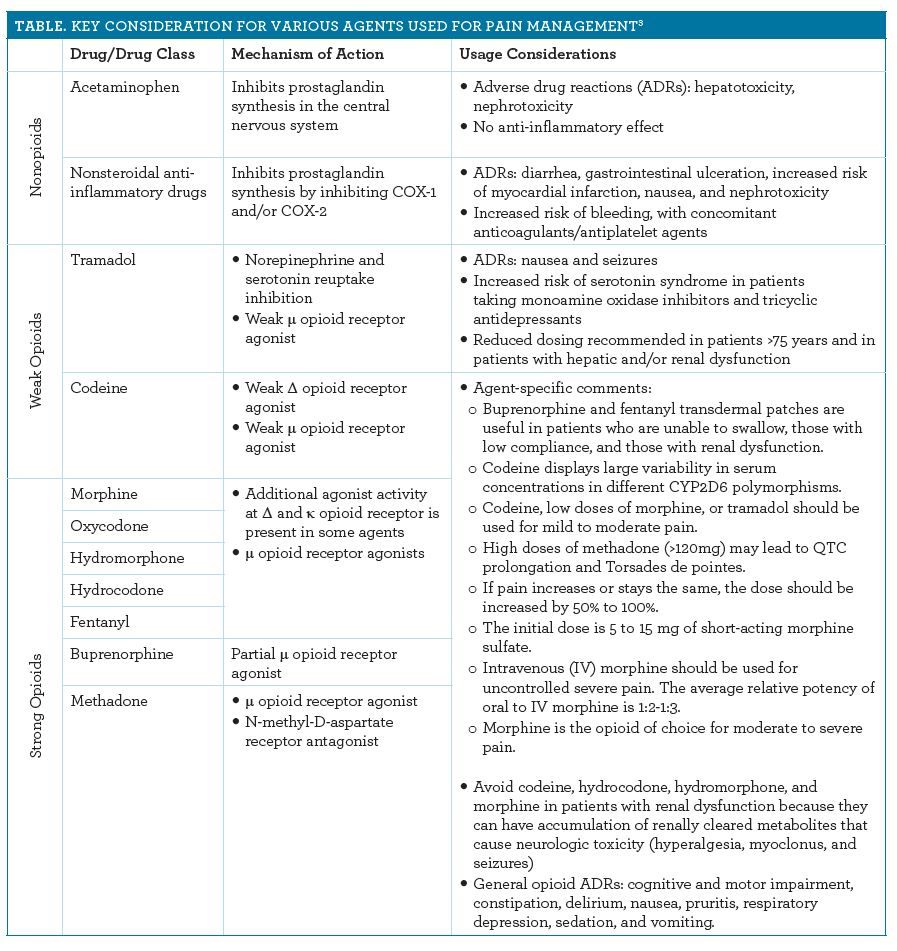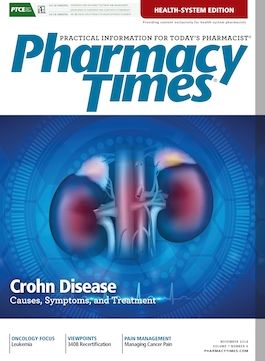Publication
Article
Pharmacy Practice in Focus: Health Systems
Managing Cancer Pain
Author(s):
Pain is a common symptom among patients with cancer, with the most recent literature suggesting that 64% of patients with advanced or metastatic cancer report pain.1 Although report results suggest that adequate pain control may be achieved in up to 90% of patients, less success is achieved in clinical practice.2
Cancer Pain Assessment
Adequate pain assessments are an integral component of cancer pain management. Initial and subsequent assessments of cancer pain at each point of patient contact are critical to optimizing outcomes and patient quality of life. During each assessment, clinicians should have patients use validated scales to self-quantify their pain intensity for their “current,” “worst,” “average,” and “least” pain over the past 24 hours.3
Based on the patients’ reports, their pain should be classified as mild (1-3), mild-moderate (4-6), and moderate-severe (7-10). In addition to pain intensity, ask patients to describe the history and quality of pain (ie, aching vs sharp vs throbbing pain, onset, pain at rest vs pain at movement, and treatment regimen) to aid in classifying the type of pain. Cancer pain can be generally divided into 2 categories: neuropathic pain, which is caused by damage to the nervous system, and nociceptive pain, which is caused by ongoing tissue damage. The response to treatment regimen and severity and type of pain determine future treatment modalities for each patient.3
In patients who are unable to self-report their pain quality or severity, because of cognitive or psychological deficits, pain can be assessed through a behavioral pain scale to assess behavioral changes, body movements, facial expressions, and the patient’s level of discomfort.3
Cancer Pain Management
The European Society for Medical Oncology (ESMO) and the National Comprehensive Cancer Network (NCCN) guidelines for cancer pain management emphasize the importance of interdisciplinary communication, nonpharmacological interventions, and patient education in combination with pharmacotherapy for optimal pain management.3,4 In terms of pharmacotherapy, once the pain severity has been established as mild, mild-moderate, or moderate-severe, treatment should be started based on the World Health Organization’s (WHO) cancer pain analgesic ladder tool, as shown in the Figure.5

Source: World Health Organization
Although the WHO analgesic ladder provides a guideline for initiation of pain agents, each patient’s regimen should be individualized based on the adverse reactions of each agent and its mechanism of action, as well as the patient’s baseline function and comorbid conditions/medications. The Table summarizes the key considerations for various agents used for pain management.3

Beyond nonopioid analgesic and opioids, the ESMO and NCCN guidelines also recommend the use of anticonvulsants, antidepressants, corticosteroids, and topical anesthetics as adjuvants at every step of the ladder. These agents have demonstrated efficacy, especially in the management of neuropathic pain. Patient education with these agents should emphasize their trial-and-error nature to avoid patients becoming discouraged.3,4
Once a pain regimen with the aforementioned agents has been established, it should be further optimized using the following strategies: comedicating with antidopaminergic agents and a laxative to appropriately treat the adverse effects of opioids, such as constipation, nausea, and vomiting; monitoring for potential opioid abuse through tools such as the Current Opioid Misuse Measure; rotating or switching opioids for patients who are failing an opioid, despite adequate dose titration; periodic reassessing for escalation or potential de-escalation in therapy based on control of pain intensity; and transitioning patients with stabilized 24-hour opioid requirements to extended-release medication with immediate-release medication for breakthrough pain.3
Each patient’s access to psychosocial support and need should be assessed during the initial comprehensive assessment and considered when choosing a treatment modality. Caregivers and patients should be appropriately educated about the types of pain and treatment regimens, including adverse drug reactions, mechanism, and onset of action. The importance of nonpharmacological interventions, such as acupuncture, heat versus ice, or positioning instruction, should also be emphasized.4
Role of Pharmacists
Pharmacists play a critical role in implementing care plans and monitoring pain symptoms for patients with cancer. They are also involved in reassessments of cancer pain by reviewing pain regimens for appropriate escalation or de-escalation, dosing conversations between different opioids, and potential drug-drug interactions. Furthermore, pharmacists can assess patient compliance to a regimen and potential opioid abuse-based refill records. Finally, pharmacists act as the bridge between clinicians and insurance companies to ensure that patients have access to their pain medications. Consequently, it is imperative that pharmacists are familiar with the management of cancer pain and validated assessment tools.
Vini Dhanky and Sowmya Mullapudi are PharmD candidates at the Ernest Mario School of Pharmacy at Rutgers, the State University of New Jersey, in Piscataway.Deepali Dixit, PharmD, BCPS, BCCCP, FCCM, is a clinical associate professor at the Ernest Mario School of Pharmacy and a clinical pharmacy specialist, critical care, at Robert Wood Johnson University Hospital in New Brunswick, New Jersey.
References
- Van den Beuken-van Everdingen MH, Hochstenbach LM, Joosten EA, Tjan-Heijnen VC, Janssen DJ. Update on prevalence of pain in patients with cancer: systematic review and meta-analysis. J Pain Symptom Manage. 2016;51(6):1070-1090.e9. doi:10.1016/j.jpainsymman.2015.12.340
- Grond S, Zech D, Schug SA, Lynch J, Lehmann KA. Validation of World Health Organization guidelines for cancer pain relief during the last days and hours of life. J Pain Symptom Manage. 1991;6(7):411-422.
- Fallon M, Giusti R, Aielli F. Management of cancer pain in adult patients: ESMO Clinical Practice Guidelines [published online July 24, 2019]. Ann Oncol. doi: 10.1093/annonc/mdy152.
- Adult cancer pain - version 1.2018. NCCN website. mghpcs.org/eed_portal/Documents/Pain/Cancer-pain-guideline-2018-nccn.pdf. Published January 22, 2018. Accessed October 2, 2018.
- WHO’s cancer pain ladder for adults. WHO website. who.int/cancer/palliative/painladder/en/. Accessed October 2, 2018.






